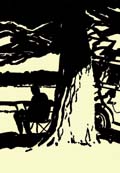
Contact me Go to home page Return to main travel page
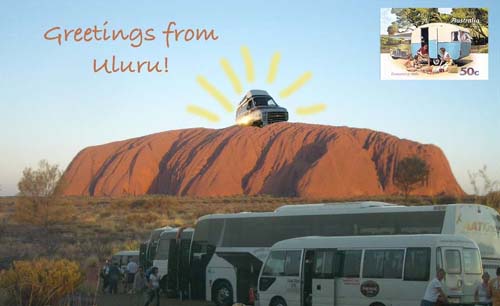 In late 2009, after we sold our house
in the Blue Mountains of New South Wales, we were given the
opportunity by our generous friends John and Susan to use
their 1985 Chevy campervan for a roadtrip. Over ten weeks in
the Australian spring we covered 12,500 km, travelling from
Sydney north along the Pacific coast to tropical Queensland,
west into the Outback as far as Tennant Creek, south through
the central desert to Alice Springs and Uluru, east from
Adelaide along the Great Ocean Road to Melbourne, then north
through Victoria and western NSW to our starting point.
In late 2009, after we sold our house
in the Blue Mountains of New South Wales, we were given the
opportunity by our generous friends John and Susan to use
their 1985 Chevy campervan for a roadtrip. Over ten weeks in
the Australian spring we covered 12,500 km, travelling from
Sydney north along the Pacific coast to tropical Queensland,
west into the Outback as far as Tennant Creek, south through
the central desert to Alice Springs and Uluru, east from
Adelaide along the Great Ocean Road to Melbourne, then north
through Victoria and western NSW to our starting point.Christine wrote and photographed the trip extensively, putting the results up on her blog, while I did a few photomontages like the two here and a lot of brush and ink paintings similar to the chiaroscuro drawings I had started to do before we went on the road. Unlike the dozens of previous trips that are chronicled on my travel page, I left the watercolours in their sack, only getting them out briefly and attempting to use them in the desert east of Alice Springs. A few reasons why: first, the scale of the trip and the number of places were so overwhelming there wasn't enough time to chronicle the landscape in watercolours; second, the light and colours are so intense, the shadows so deep and black, that I decided to use Chinese ink as a sketching medium and save more elaborate and colourful works for later, maybe (in oils); third, it's so bloody hot and the flies are so plentiful in most areas that I can only marvel at the stoicism of Australian plein-air painters. And although it might seem odd to travel in such a colourful place with only black ink, I believe these chiaroscuro drawings capture a lot of the essential harshness of the Australian climate and landscape (and of course, if I were a photographer and used only black and white film people would say 'ooh, how sophisticated'). So my artwork from this trip followed quite a different path, concentrating on the experience of the campervan and caravan parks, the people along the way, plus some buildings and landscapes which "work" in the medium, more or less. The challenge with brush and ink is to create images where the shadows and forms define other shapes – in other words, where you're not drawing with outlines – and where the pattern of black and white on the paper is pleasing in its own rather abstract way. Like all pictures, representational or not, they ought to look as good upside down as right side up. In the main they are created images rather than pictures of specific places, if you catch my drift: the subjects of the artwork end up being defined by invention and arrangement of the background. There is a page of more recent "chiaroscuro" brush-ink drawings here. 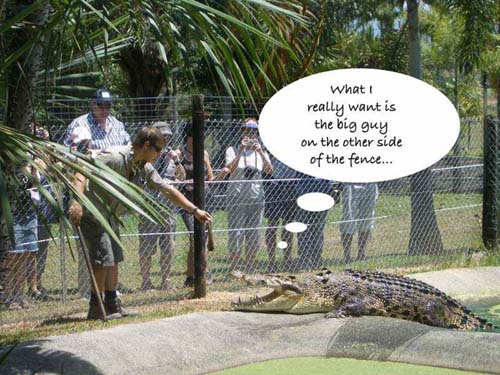 Lunch on a crocodile farm in Innisfail, Queensland |
|
On
the Road
Travelling in a campervan; caravan parks a jumble of tents,
overloaded cars, ratty old trailers, colourful towels strung
from clotheslines, children riding bikes, lawn chairs strewn
about and meaty barbecue smoke drifting by. Some of the
older parks, like the one at Mission Beach in tropical
Queensland, have many long-term residents whose modest
caravans have been added to with sheds, canopies, plants and
outdoor furniture. There's a kind of ramshackle village
atmosphere to these places, which hangs by a thread as
nearby properties get cleared and redeveloped with luxurious
villas and hotels. Mission Beach and Black's Beach near
Mackay were two caravan parks sitting right on the beach on
the edge of the Coral Sea; we were told by the manager at
Mission Beach to keep an eye out for "salties" (salt-water
crocodiles) which swim from the estuaries along the beaches
in springtime looking for mates and food. Many caravan parks have wifis, so you see people sitting outside with their laptops and notebooks doing their email. Even people with tents rent powered sites because they have to recharge all their cameras, phones and computers. And when you walk through the parks in the evening, you see campers sitting in the glow of their screens as, in an earlier era, they clustered around campfires. 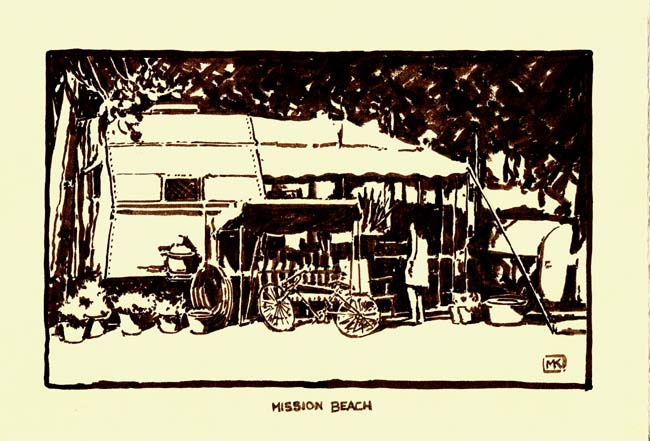
A long-established caravan in an old park at Mission Beach, for sale for $10,000 as the owners were moving to Darwin. 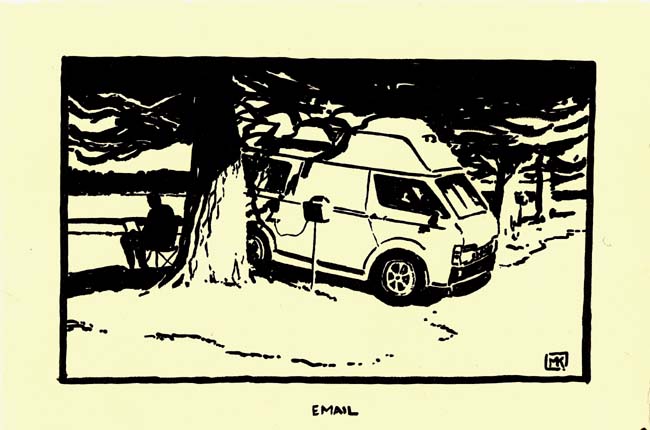
Probably a German or Dutch tourist, they being the ones who rented the modern campervans from companies like Britz and Apollo, checking his email at a caravan park on the Great Ocean Road in Victoria. 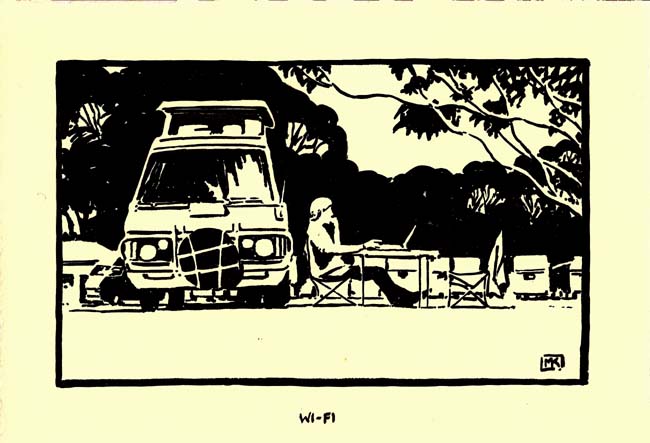
An old Toyota hippie van with a young man, maybe European or maybe Aussie, spending the late afternoon after a day's surfing surfing the net. 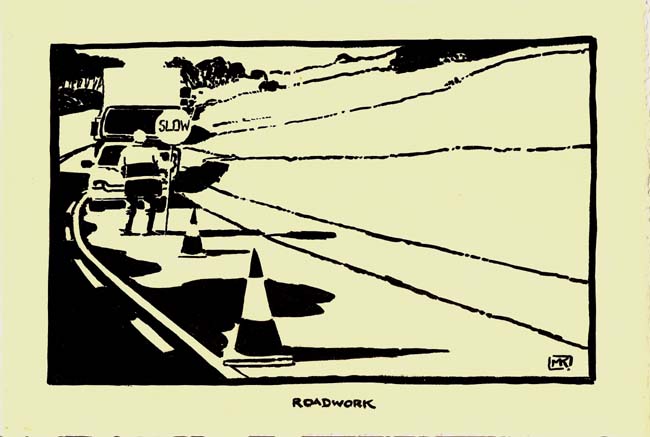
A flaggie (?) in his fluoro stops traffic in the blazing tropical heat as Queensland tries to upgrade its road network to accommodate the huge influx of 'sea-changers', that is people migrating and retiring to the coast. 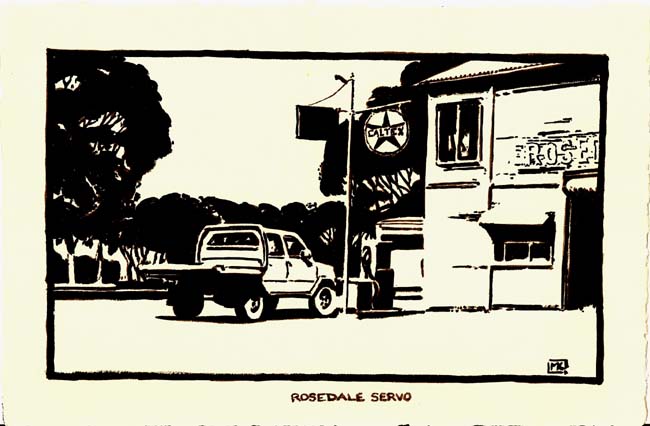
A rare old-fashioned garage in a tiny Queensland town. Most of the \'servos\' in Oz now look like the ones everywhere else in the world. 
Backpackers travelling. Some days we found we were driving almost in a convoy with a few other campervans, and stopping at the same few sites, especially in the desert where there were so few places to stop. 
Based on the bookies and punters at the country races in Charters Towers, Queensland. 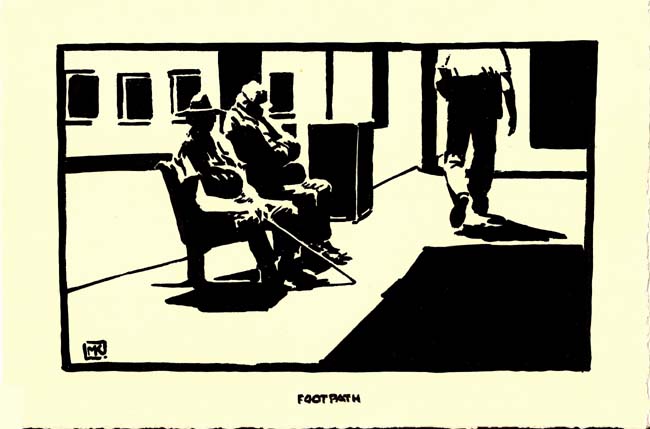
The footpath a.k.a. sidewalk in a country town 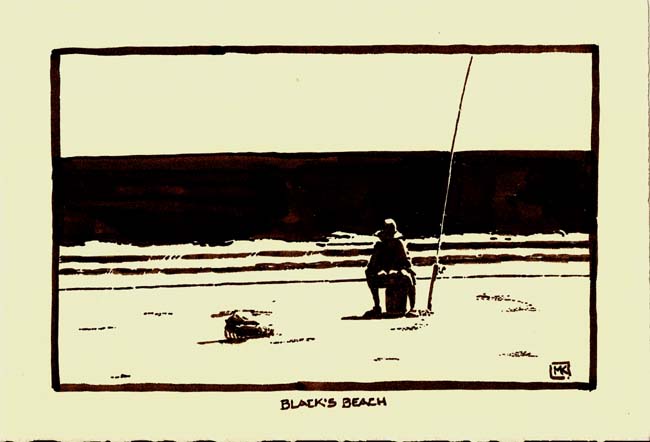
A contented surf fisherman on the seashore in front of
the Black's Beach caravan park near Mackay. SOLD 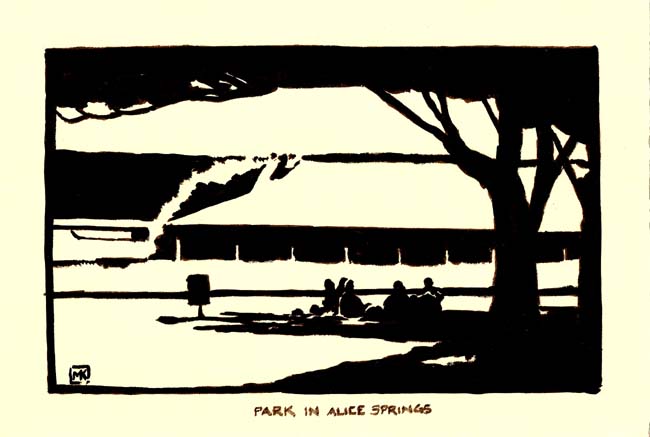
In the parks in Alice Springs, in the blazing heat, families of Aborigines sit together in the deep shade, hour by hour... SOLD 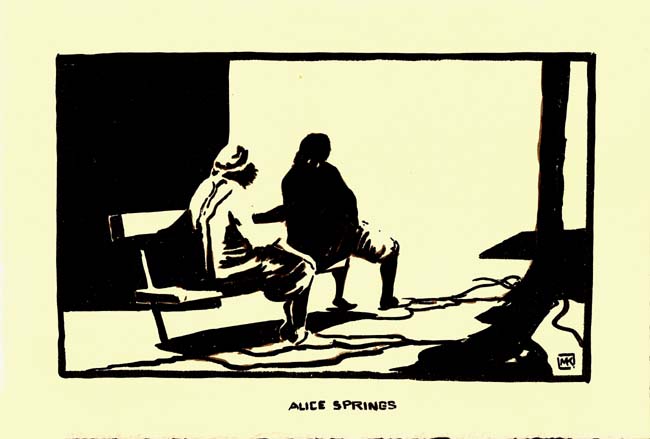
Aboriginal women on a bench in Alice Springs. Some women
sell their paintings and handicrafts in the parks and
along the pedestrian mall; others just sit by the hour. 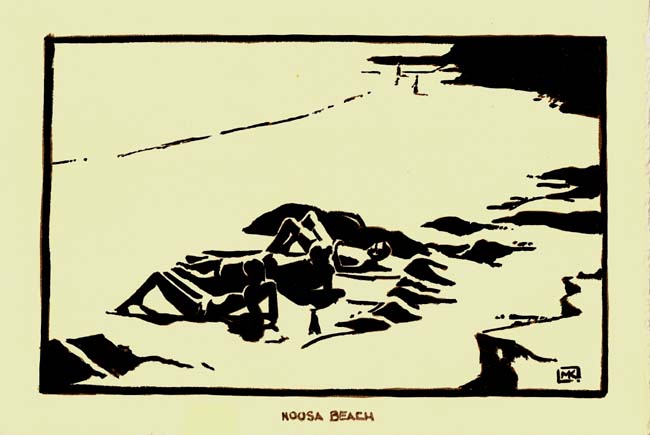
An arrangement of sunbathers and rocks on the beach at
Noosa Heads, Queensland. 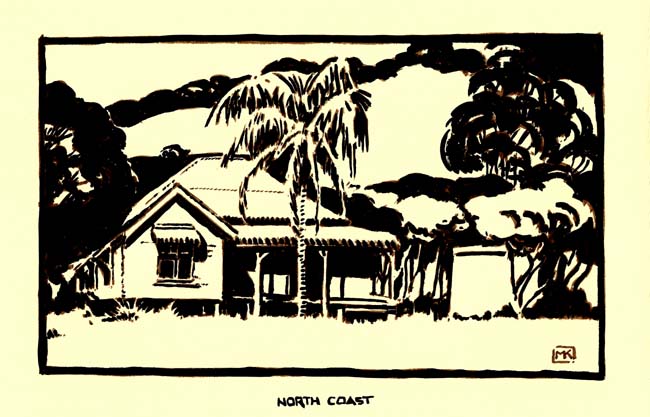
Based on an old building near Nimbin, the hippie capital of Oz just inland from Byron Bay on the north coast of New South Wales, this place has the bullnose verandah, gabled parlour and hipped roof of a classic farmhouse. SOLD 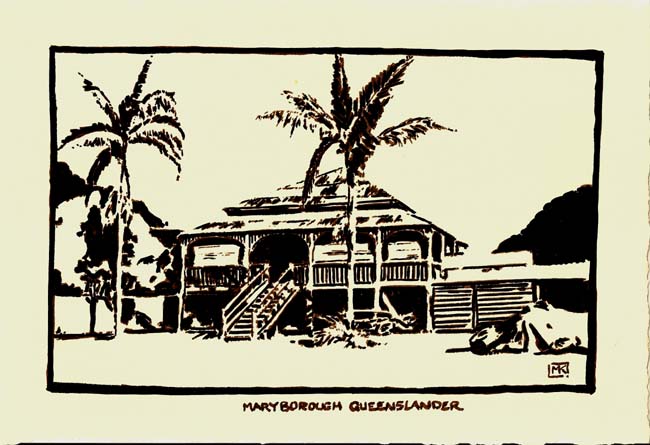
A Queenslander in the old colonial port town of
Maryborough, with screened verandahs and a long staircase
descending to the yard. SOLD 
A classic Queenslander in a little sugar cane town. 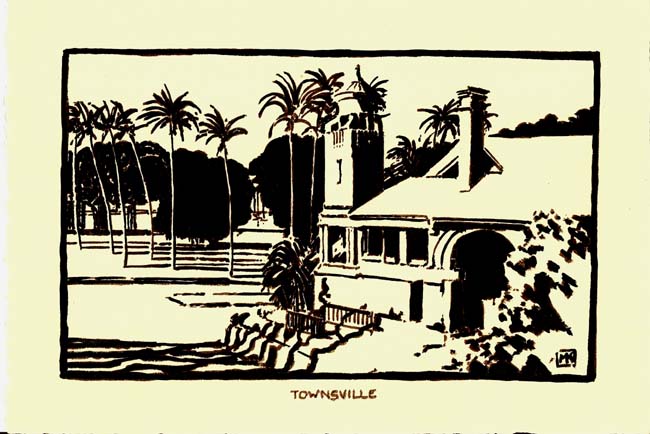
One of the beautiful colonial administration buildings in Townsville, the largest city in tropical Queensland – that is, the part of the state north of the Tropic of Capricorn. 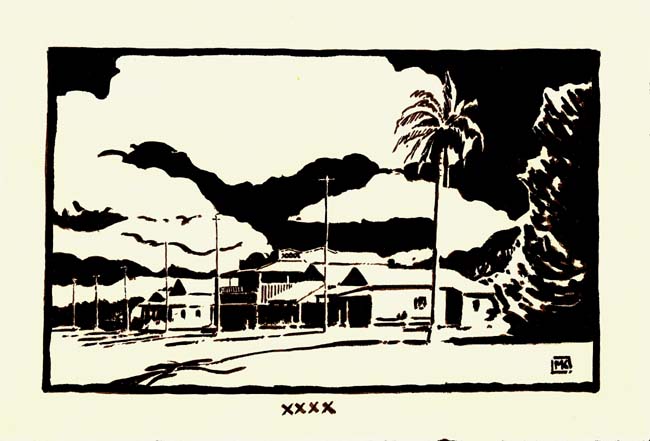
XXXX, pronounced 'for-ex', is the great Queensland beer,
its distinctive logo seen all over the State on pubs such
as this one in a little town whose name I've forgotten.
Hard to see the logo on the pub roof – I only had one
rather large brush. 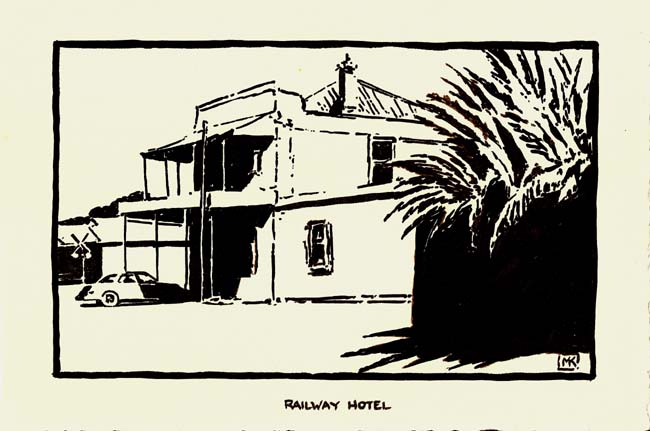
Another pub, this one in Gladstone in South Australia, an old railway crossroads famous or notorious for having tracks with three different gauges coming into its yard. 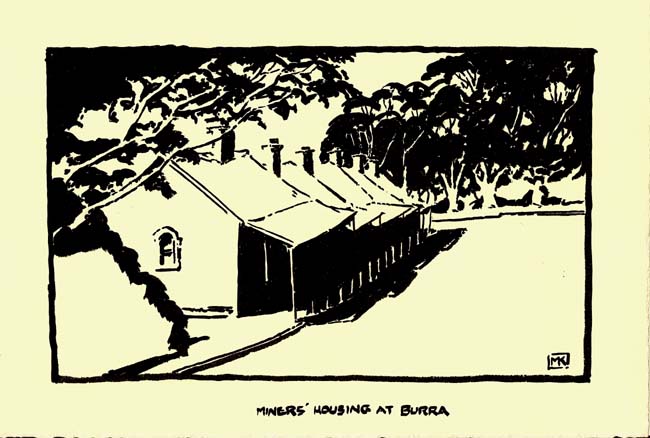
One side of a quadrangle of mine workers' terraces called Paxton Square in Burra, South Australia. The colony was going bankrupt in 1850 when copper and gold were discovered at Burra, and the terraces were built soon after. They are available for rent now to tourists. 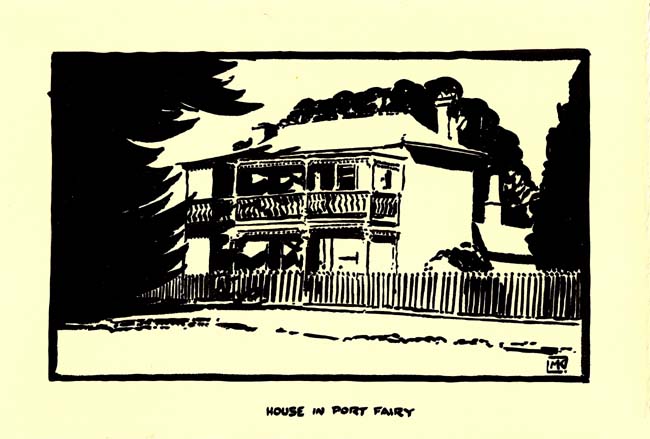
Port Fairy is a fishing town on the southern ocean near the Victoria-South Australia border. 
Some roadside buildings in southern Victoria near the ocean, their shapes defined by the pines planted to break the winter winds. 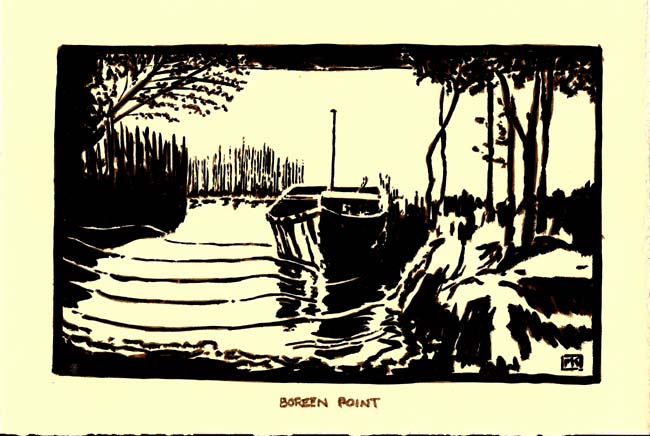
Boreen Point juts into a placid, shallow lake near the mouth of the Noosa River on the Queensland Sunshine Coast. SOLD 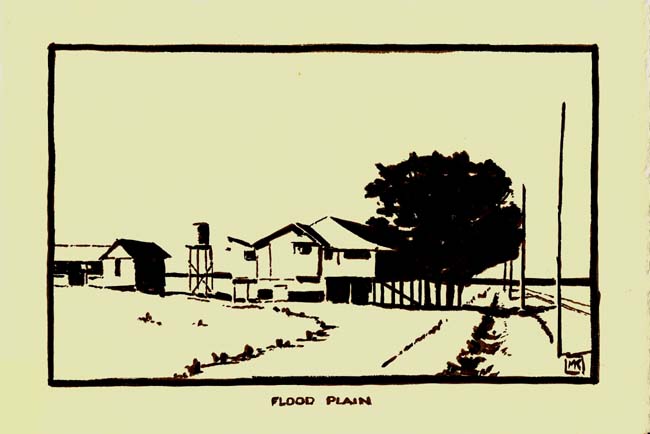
The rivers of northern NSW and Queensland flood regularly, creating fertile soil for the sugar cane and forcing farmers to build high in the air. 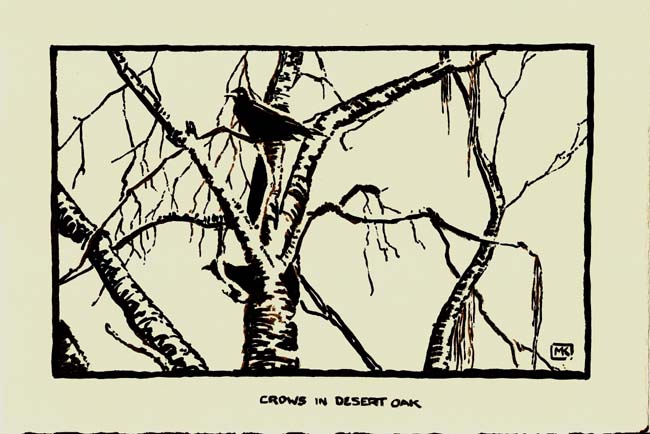
Crows manage to thrive in the Australian desert, perching in the desert oaks and waiting for heat, dryness or vehicles to give them a meal. 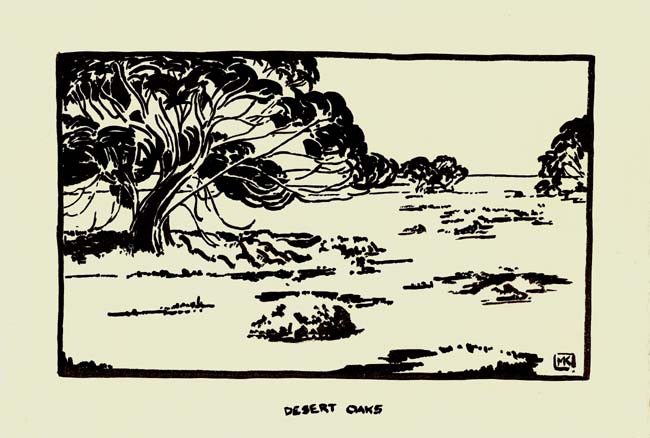
Graceful desert oaks sway in the hot wind throughout much of the arid lands of central Australia, surviving in sandy soil with the mallee and spinifex on the deluges that fall, in a good year, once or twice. 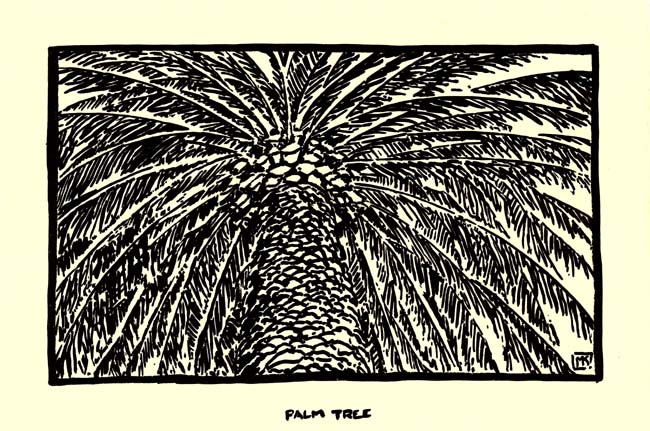
Rather self-explanatory, this one... SOLD |